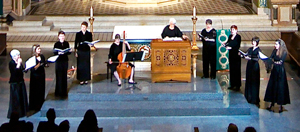by Daniel Hathaway

That program, which features choral and instrumental music from 17th century Italian and Mexican convents, was itself the result of a chance encounter. Hargis was already thinking of constructing an Italian program drawing on the vast collections of unpublished music in convent libraries — partly suggested by Craig Monson’s book, Nuns Behaving Badly: Tales of Music, Magic, Art, and Arson in the Convents of Italy. “It reads like a trashy novel! Then a graduate student at the University of Chicago, where the Newberry Consort is based, brought a collection of 17th century Mexican music in the Newberry Library to my attention: six great big books that go on a stand so you can circle around and sing from them. It’s a fantastic treasure. They’re lavishly decorated in a primitive way that looks like folk art.”
The books include some music from the old world — Victoria and Guerrero — but also serve as the unique source for the works of the Mexican composer Juan de Lienas. “He was quite a character. He was thought to be a priest, but there seems to have been quite a lot of scandal or at least ill feelings on the part of the convent scribes,” Hargis chuckles. “There are scribbled pictures of him in the margins with devil’s and cuckold’s horns.”
Hargis is excited about replicating the forces for which the music was originally composed. Celestial Sirens involves two choruses of women, each with four singers “who sing all the parts from very high soprano to bass — down to E or F below middle C.” Hargis experimented on herself to see if that bass range was possible for a female voice. “If I as a soprano could access those low notes in a safe way, I could ask my colleagues to do the same. My husband remembers some very strange sounds coming from the practice room!”
Wednesday’s singers will also reflect the range of ages of members of a 17th century monastic community. “Every decade from the twenties to the sixties is represented, which is really typical of convents of the time. Very frequently vocations weren’t involved; whole families of women would go to live in convents — perhaps a woman with her widowed mother, her maiden aunt and maybe a younger sister who wasn’t marriageable would end up there. Their families would give them a dowry to ‘marry’ the church and they might have their own wing with little apartments.”
Some, on the other hand, went there against their will. “In the Italian half of the program, our gambist, Katherine Shuldiner, who I’ve known in Chicago since she was a teenager, will play Angelo Notari’s variations on La monaca — ‘Mother, don’t make me a nun. I don’t want to be one. I don’t want to have to sit there all day long listening to prayers and having Mother Superior picking on me.’”
To give the audience a taste of the period sounds the new Richards, Fowkes and Co. instrument is designed to reproduce, organist Frances Fitch will play music from both the old and new world. “One piece, Vidi aquam, by Victoria, intersperses chant with verses on the organ. The sound is just magnificent,” Hargis says. “We’re utterly thrilled to have that resource so close to Case, and it’s set up in a gallery just like in the seventeenth century.”
Click here to download program notes for Celestial Sirens.
Published on ClevelandClassical.com March 19, 2013
Click here for a printable version of this article.



